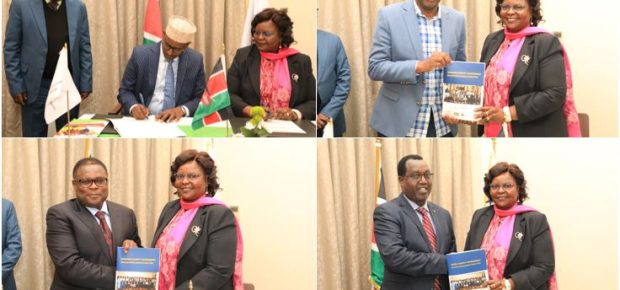
CRA and World Bank roll out second phase of County Revenue Enhancement Plans
The Commission on Revenue Allocation (CRA), in partnership with the World Bank, on 21st August 2025 launched the second phase of the County Revenue Enhancement Action Plans (REAPs), marking another step in strengthening counties’ Own Source Revenue (OSR). The event, hosted at Sarova Panafric Hotel, brought together leaders from the national and county governments, including Wajir, Murang’a, Bungoma and Nandi counties — four of the 11 counties now engaged in the initiative.

REAPs are county-specific blueprints designed to help devolved units tap into their revenue potential, improve service delivery and drive sustainable local development.
“While OSR growth has been commendable, there remains significant untapped potential — estimated at Kshs. 216 billion across the 47 counties,” said CRA Chairperson CPA Mary Chebukati, citing Article 216(3b) of the Constitution that tasks CRA with enhancing revenue sources.
Gains — But at What Pace?
Since the advent of devolution, OSR has steadily grown from Kshs. 26.3 billion in FY 2013/14 to Kshs. 59 billion in FY 2023/24, and further to Kshs. 69 billion in FY 2024/25 — a 17% jump in a single year. While these figures are promising, they raise a pressing question: is the growth fast enough to meet counties’ ballooning demands for healthcare, infrastructure and public services?
CPA Chebukati admitted that CRA lacks the resources to roll out REAPs across all 47 counties, appealing to development partners for continued support. This in itself highlights a paradox: counties are being urged to maximize their own revenues, even as the national institutions guiding them rely heavily on external funding.

World Bank’s Caution
World Bank Lead Economist, Marek Hanusch, praised REAPs for improving counties’ OSR performance, but warned against quick-fix measures that may backfire.

“Counties must avoid approaches that discourage economic activity or create inequality,” he said. “Equally important is efficiency, transparency, and accountability in spending — these are what strengthen the social contract and build public trust.”
His remarks touch on a critical fault line in devolution: even as counties work to raise more revenue, misuse and weak accountability in spending risk eroding citizen confidence.
Success Stories and Gaps
Among the counties in Phase Two, Wajir stood out with a dramatic 110% growth in OSR in FY 2024/25, more than doubling its 55% target. Overall, however, counties reached about 67% of their projected revenue collections.

CRA Commissioner Khadija Juma, chair of the Public Finance and Management Committee, underlined the challenge: “Counties are only collecting two-thirds of what they should. The gap is glaring.” She called for digitization, updated policies, and stronger enforcement to bridge this divide and reduce over-dependence on national transfers.
The Persistent Obstacles
Despite progress, county revenue systems remain plagued by familiar weaknesses:
- Outdated or incomplete valuation rolls
- Weak or absent tariff and pricing policies
- Low public trust and awareness, feeding tax resistance
- Unintegrated revenue management systems
- Inadequate monitoring and enforcement capacity
These shortcomings are not new — they have been cited in audit after audit — raising concerns about whether REAPs will succeed where earlier initiatives faltered.
What REAPs Recommend
The new action plans prescribe practical fixes, including:
- Digitized billing and claims in healthcare
- Comprehensive business mapping and licensing
- Upgraded market infrastructure
- Modernized property rate systems using GIS
- Stronger legal frameworks and updated county bylaws
Counties present also emphasized peer learning — sharing best practices across regions — and recognized that public trust is central to tax compliance. Citizens, after all, are more likely to pay when they see visible results from their contributions.
CRA’s Call to Counties
CRA Vice Chairperson Koitamet Olekina reminded counties that REAPs are not “copy-paste” templates but tailor-made strategies to address specific challenges. He urged counties to allocate adequate resources, provide political goodwill, and actively monitor implementation.
The Bigger Picture
The launch brought together not just county governments but also national institutions such as the State Department of Devolution, the Office of the Controller of Budget, the Public Sector Accounting Standards Board, development partners like the EU, and platforms such as the County Assemblies Forum.

The breadth of participation underscores one fact: improving county revenues is not just a financial issue but a governance test. Counties are under pressure to show that devolution is not only about dividing resources but also about growing them — and doing so fairly, efficiently, and transparently.
A Collective Effort
The launch was more than just a technical unveiling; it was a show of collective commitment to strengthening devolution. Leaders from Bungoma, Uasin Gishu, Nandi, Wajir, Murang’a, and Machakos counties shared their experiences and ambitions, underscoring the urgency of closing the revenue gap.
National institutions were also in the room: the State Department of Devolution, the Office of the Controller of Budget and the Public Sector Accounting Standards Board — each reminding counties that stronger revenues must go hand in hand with prudent public financial management.
Development partners, including the World Bank and the European Union, added their voice, affirming that global support for Kenya’s devolution hinges on transparency, accountability and the ability of counties to stand on their own financial feet.
The Intergovernmental Budget and Economic Council (IBEC) and the County Assemblies Forum reinforced the importance of political goodwill and legislative backing in making REAPs work.
Within CRA itself, the leadership team — Chairperson Mary W. Chebukati, Vice Chairperson Koitamet Olekina, Commissioners Khadija Juma, Jonas Kuku, Dr. Isabel Waiyaki, Dr. Jalang’o Midiwo and technical and support staff — engaged, pledging continued support to the county governments. Together, the mix of county leaders, state institutions, lawmakers and development partners painted a clear picture: enhancing revenue is not just about figures, but about governance, trust and a better system of devolved governance in Kenya.

